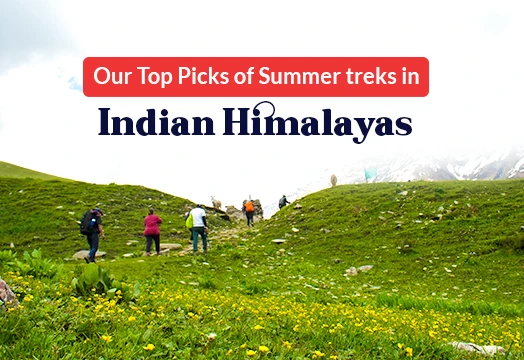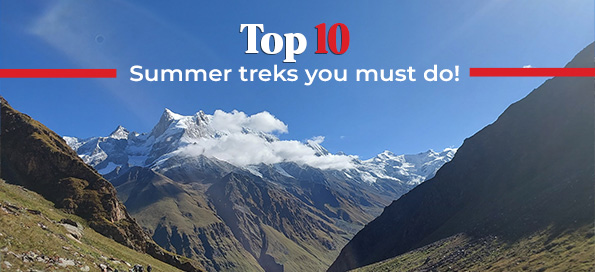
Region
Uttarakhand | India
Duration
8 Days
Max Altitude
14600 Ft.
Trekking Km
46 KM
Grade
Moderate to Difficult
Help & Support
+91 9368882322 info@trekthehimalayas.com10:00 hrs to 18:00 hrs | GMT +5:30
Monday - Saturday | Sunday Closed
16400 /Person
- September-2024
- October-2024
- May-2025
- June-2025
- +5% GST (goods and services tax)
- Services Gangotri to Gangotri.
- Meeting Point( Pickup/ Drop Point ): Prince Chowk, Dehradun
Reporting Time: 6:00 a.m. Drop Time:6:30 pm to 7:30 pm (Timings are subject to change based on weather and road conditions). Please reach Dehradun a day before to avoid any delays.
Addons
Insurance 280
-
Insurance is Mandatory.
-
Non-Indian rates are slightly higher. Trek coordinator will provide balance payment link post-booking.
- Get insurance through us or elsewhere. If not through us, email for a refund after booking.
-
Cancellation 4 or more days before the start of the trip results in a 100% cash refund.
-
Cancellation less than 4 days from the start of the trip results in no refund.
Transport 2500
-
Transportation Dehradun to Gangotri & retun is optional
-
Choose add-ons during booking. If missed, log in and add them later
-
Book transportation at least 10 days before the trek.
-
Cancellation 4 or more days before the start of the trip results in a 100% cash refund.
-
Cancellation less than 4 days from the start of the trip results in a 50% cash refund.
-
Cancellation after the trip date does not qualify for a refund.
Offload 2100
-
Backpack offload is optional
-
Choose add-ons during booking. If missed, log in and add them later.
-
Book off-load at least 10 days before the trek.
-
For offline bookings at the base camp, a convenience fee of Rs. 2900 applies.
-
Cancellations made before the trip date will receive a full refund.
For more information. Please complete this form.
Help & Support
+91 9368882322info@trekthehimalayas.com 10:00 hrs to 18:00 hrs | GMT +5:30
Monday - Saturday | Sunday Closed
Overview
Trek Name: Gaumukh Tapovan Trek
Days: 8
Adventure Type: Trekking
Base Camp: Gangotri
Season:Summer | Autumn |
Month:May | June | September | October |
Country: India
Altitude: 14600 Ft.
Grade: Moderate to Difficult
Rail Head: Dehradun
Stay: Camping (Twin sharing) & Hotel/Guesthouse : triple, quad, dormitory (separate for male and female)
Food: Meals while on trek & at Hotel/Guesthouse (Veg)
Location: Uttarakhand
Distance: 46 Km.
Trail Type: Point to point trail | Camping at the same location upon returning.
AirPort: Jolly Grant Airport, which is 28 km away from Dehradun
Highlights:
- +5% GST (goods and services tax)
- Services Gangotri to Gangotri.
- Meeting Point( Pickup/ Drop Point ): Prince Chowk, Dehradun
Reporting Time: 6:00 a.m. Drop Time:6:30 pm to 7:30 pm (Timings are subject to change based on weather and road conditions). Please reach Dehradun a day before to avoid any delays.
Gaumukh - Origin of Holy Ganga
History of Gaumukh Tapovan
Courtesy of celebrated mountaineers Shipton and Tilman, we have a trek route traversing the entire stretch of Gaumukh Tapovan. Since its discovery, Gaumukh Tapovan Trek has been a favorite spot for both spiritual seekers and adventure enthusiasts. The word Gaumukh translates to “cow’s mouth” and derived its name as the structure of the glacier represents the same. Tapovan Meadows on the other hand derived its name as the meadows are a haven for saints and sages. The word “Tapovan” translates to a place where one can meditate. The Gomukh Tapovan Trek is a mystical thrilling journey through the mystical environs of the Gangotri region. Whether you are someone who enjoys a great adventure or someone who is a seeker of divinity, this trek is a great option for you.
Why Gaumukh - Tapovan Is A Must-Do Trek?
Gaumukh Glacier - Source of Ganga
- Translating to the Mouth of a Cow, Gomukh marks the sacred source of the Bhagirathi River.
- Embark on a journey to the pristine landscapes where the Ganges begins its sacred flow.
.webp)
Who Can Participate
- Age; 14 years +.
- First timers can apply; previous trekking experience is more appreciated.
- The climber must be fit and have sufficient stamina to cover 5 km of distance in 30 minutes without stress.
- The climber should be able to carry a 10-15 kg backpack.
Itinerary
Dehradun To Gangotri
- Altitude: 3,100 m/ 10,200 ft.
- Pick-up time: Dehradun railway station 6 am.
- Drive distance: 250 km (8-9 hrs).
- The local market and network are available.
- Stay in guesthouse.
- Route: Dehradun - Mussorie - Dhanulti - Chamba - Uttarkashi - Harshil - Gangotri.
Note: We will pick you up at 6 am from the Dehradun railway station for an 8-9 hour long journey to Gangotri.
Get all set to begin the journey from Dehradun in the morning at 6 am. The day will be longer as you will cover 250 km to Gangotri. It will be a wonderful 8-9 hour ride along the mighty mountains. We start early in the morning so that we can reach Gangotri by evening.
Located at only 35 km from Dehradun, the first major attraction will be Mussorie, the famous hill station. The Hill station offers majestic sights of the Shivalik Ranges. After breakfast and a bit of sightseeing through Dhanulti, Chamba, you will arrive at the land of Gods, Uttarkashi.
Uttarkashi, the ‘Kashi of the north’ lies on the banks of river Bhagirathi and is home to the renowned Kashi Vishwanath temple. It is a picturesque town where you will see all the temples and religious people around, making you believe that you truly are in the land of Gods. The river Bhagirathi takes you to the scenic Harshil village. Harshil is known for apple orchards everywhere giving a retreat to your eyes. Harshil is the best place to enjoy the serene evening amidst the mountains.
Even after a long ride to Gangotri, you would wish it wouldn’t end. Gangotri is on the banks of river Bhagirathi, pervaded by pilgrims. You can roam in the local market, interact with local people, and share amazing pictures with your friends, because of the good network availability. During the night have a great homemade dinner and rest in the guest house.
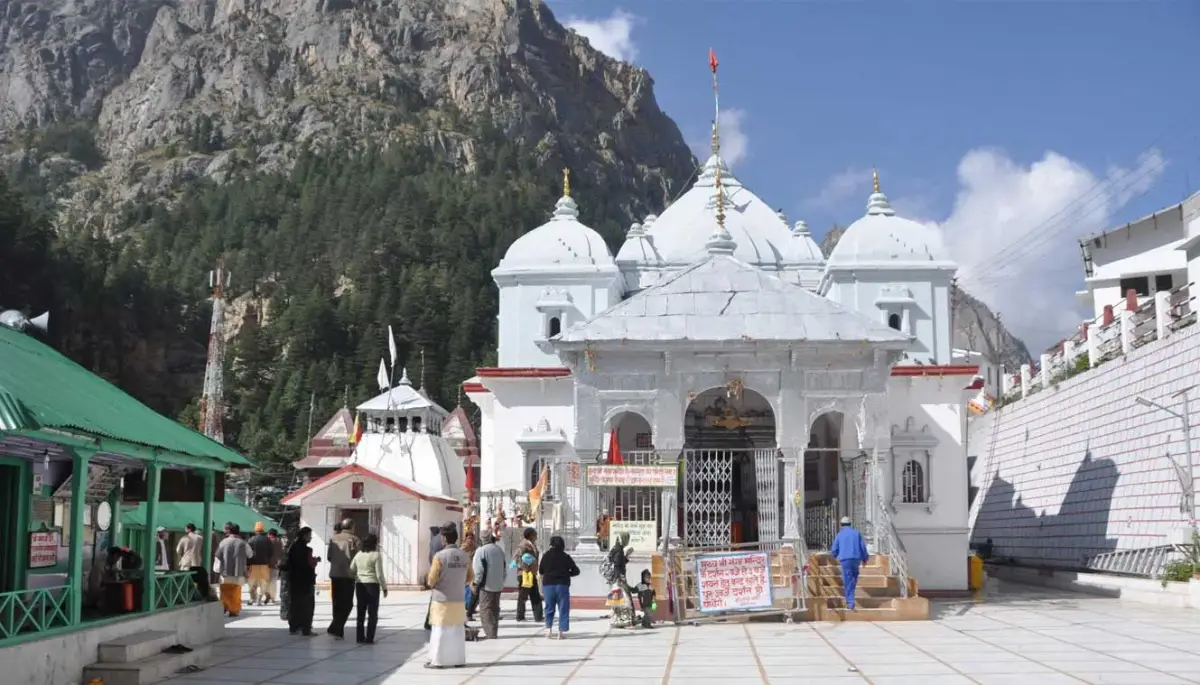
Acclimatization Day At Gangotri
-
Altitude: 3,100 m/ 10,200 ft.
-
Gangotri Temple - Gangotri is one of the Char Dhams of Uttarakhand.
-
After breakfast visit Pandav Gufa, Bhagirath Shila, Surya, and Gauri Kund.
-
Post lunch can visit Gangotri Temple or go shopping.
-
Acclimatization walk around Gangotri town.
-
Stay in the guesthouse.
Good morning in the holy land of Gangotri!
Have breakfast and enjoy the entire day just being alive in the religious vibes. The entire region brims with spiritual fervour and Gangotri is a heaven not just for spiritual seekers but also for adventure enthusiasts as well.
Now that you are at 10200 ft height, today is the day for acclimatization. Acclimatization is like a health supplement for your body to get used to the environment and low temperature. At TTH, we take acclimatization very seriously as it is one of the key contributors to the success of a trek. Take acclimatization walks around Gangotri in the evening. The Gangotri temple is the biggest temple that was built in the 18th century. Apart from that, you can visit the Bhagirath Shila, a holy rock where King Bhagirath worshipped Lord Shiva, and Pandava Gufa where Pandavas rested. Surya Kund and Gaurikund are two hot water springs that you can visit as well, Surya and Gauri Kund are both located on either side of an iron bridge near the temple.
You will see many foreigners meditating and roaming around. Spend the night in the guest house and get ready for the upcoming trek.
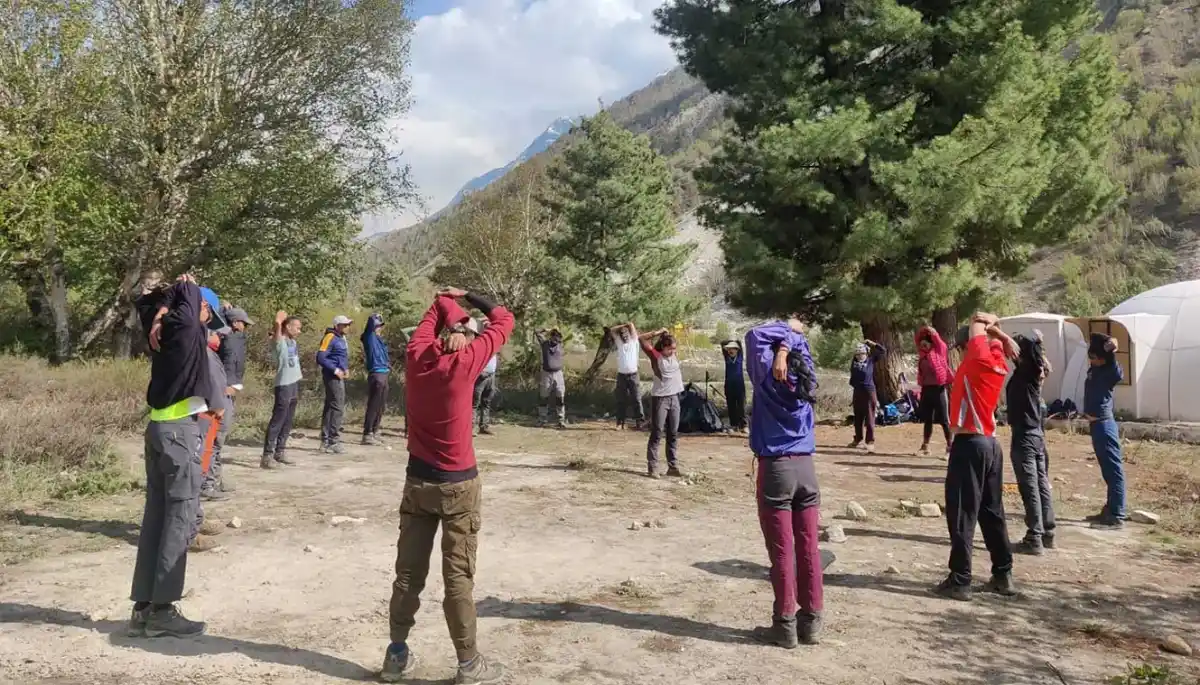
Gangotri To Chirbasa
-
Altitude: 3,550 m/ 11,700 ft.
-
Trek Distance: 9 km | 5 to 6 hrs.
-
Altitude Gain: 450 m/ 1,500 ft.
-
Entire trek in Gangotri National Park.
-
Accommodation in tent.
-
Hot lunch is served at the campsite.
-
Campsite under the pine forest.
-
Moderate level of gradual ascent.
-
Spring and manmade water points are available.
-
Evening acclimatization walk.
Have a full breakfast and take steps ahead to embark on the trek through the mountains. We start early from Gangotri and head towards the Chirbasa campsite. The trek starts from a forest check post and after getting your permits checked proceed on the trekking trail on the left side of the mountain. You will be walking through the pine forests alongside the gurgling Bhagirathi river. There will be gradual ascents but it will be an easy 4-5 hours trek. You will come across many waterfalls and natural streams where you can refill your bottles. Throughout the route, beautiful Sudarshan Parbat (21,345ft) will accompany you. The entire walk will be in the Gangotri National Park. Once you cross the third ridge on your trek, you will be greeted with a mesmerizing view of the valley. The fragrance of the blue pine and fir trees is enough to soothe your senses.
This will be the most scenic campsite, with the Bhagirathi river gushing on the right, lying in between the mountains under the pine trees. The campsite offers the first views of the Bhagirathi Sister peaks, Bhagirathi I, II, and III ( 6856 m, 6512 m, & 6454 m respectively) sharing space with Manda Peak, Bhrigu Parbat, etc. Far away you can also make out the Gaumukh Glacier.
Revive yourself by having lunch. Enjoy the blissful evening by the side of the Bhagirathi river, you can also take an acclimatization walk to explore the area. To make the day more adventurous you will be spending the night in tents. Of course, besides the flowing river, between the mountain peaks, under the pine trees…!!!
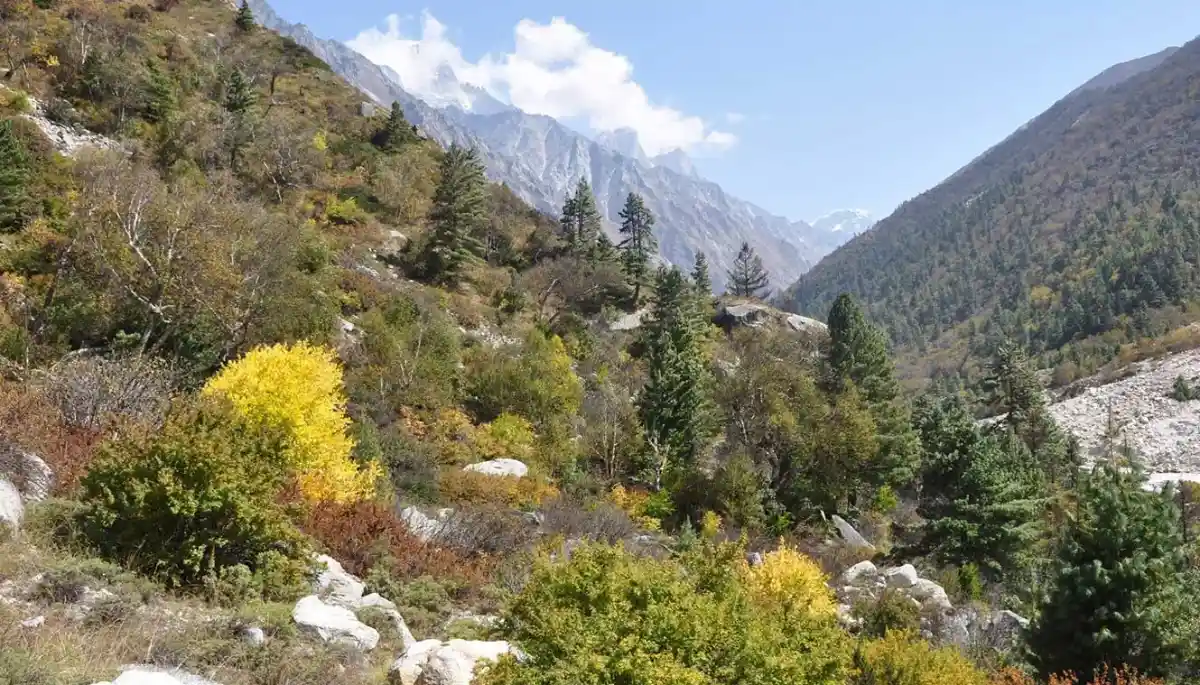
Chirbasa To Bhojwasa
-
Altitude: 3,800 m/ 12,500 ft.
-
Trek Distance: 5 km | Duration: 2 to 3 hrs.
-
Altitude Gain: 250 m/ 800 ft.
-
Accommodation in a tent.
-
Reach campsite for lunch.
-
Easiest day of the trek.
-
Moderate level gradual ascent.
-
Birch (Bhojpatra) forests in the area.
-
Ashram, police post (SRDF), and rest house available.
-
Mt. Bhagirathi massif view from the camp area.
-
After lunch, acclimatization walk in the surrounding areas.
Wake up with the stunning fluorescent views of sun rays on the mountain peaks, and get refreshed to trudge again. This will be the easiest 2-3 hours trek having a gradual ascent. The trail widens now with closer views of the Bhagirathi peaks. You will cross some landslide sections easier to walk upon. About 45 minutes into the walk you will reach the first ridge section and as you keep walking, the Bhagirathi group of peaks comes closer and closer. Soon you will reach a landslide-prone area filled with boulders and a stream running across your path. There will be another ridge after this point with about 8 to 9 landslide-prone bends, be mindful of falling rocks in this area. After the trek, you will see a bridge over a stream and a plain terrain where tents will be laid for you, this is Bhojwassa.
The name Bhojwasa came from Bhojpatra trees or the Birch trees, which are in abundance there. This is the widest part of the valley serving you the first view of Mount Shivling. You will find an ashram, police post, and a rest house, as well as some igloo-like houses. You can opt to stay in those houses but that requires permission.
Chill around in the noon after having lunch at the campsite. You can capture the splendid camping area, or you can walk 300 m above the Bhojwasa campsite from where you can get a striking view of the valley. Spend the cozy cold night in the tents.
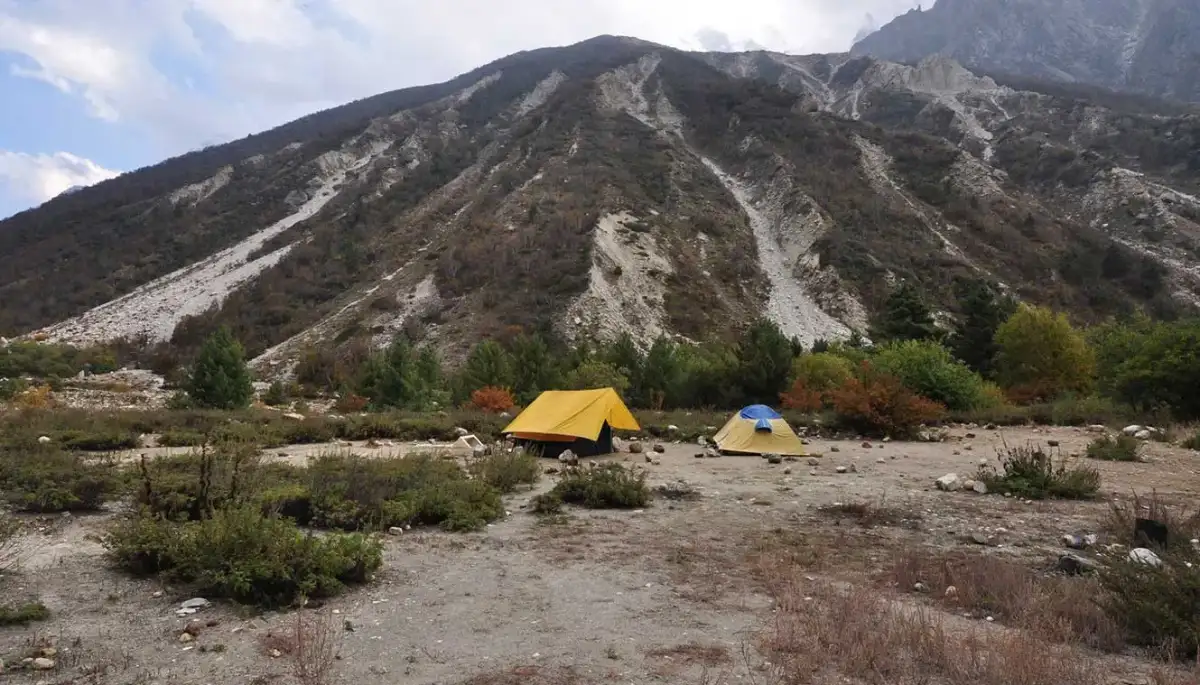
Bhojwasa To Tapovan
-
Altitude: Tapovan - 4,450 m/ 14,600 ft.
-
Trek Distance: 6 km| Duration: 7-8 hrs.
-
Altitude Gain: 650 m/ 2,100 ft.
-
Accommodation in a tent.
-
Hot lunch/ packed lunch.
-
No water points, it is advisable to carry at least 2 litres of water.
-
A challenging day on the trek.
-
Carry energy bars, ors, and water.
-
Trek begins over rocky boulders and becomes noticeably steep gradually over the rocky terrain.
-
Cross the river by means of a trolley.
-
You might see mountain goat/ Ibex near your campsite.
-
Tapovan camp is surrounded by giants - Mt. Shivling, Meru, Manda, the Bhagirathi group, Kedar Dome, Kharchakund, and many more.
Today we will trek from Bhojwasa to Tapovan. It is a 6 km-long trek so eat full, get packed lunch, fill water bottles (there are no water sources on the route), carry energy bars, and lots of excitement.
To reach the Tapovan, we need to cross the river using a manually pulled trolley over the bridge. It is a unique experience and this method is often used as a method of river crossing in the mountains where there are no bridges in place. It takes about an hour for the entire batch to cross the river via a trolley so don’t be impatient.
After crossing the river, you will walk for about 2 km with rocks and stones on either side, this is also a potential rockfall-prone zone, so we will try to cross the area before lunchtime to avoid any potential rockfalls. After crossing this zone, you have to cross the Akash Ganga River. Look for spots from where you can cross the river and if the water flow is high then you will have to take your shoes off to cross the stream.
We will have lunch after crossing the river. Tapovan is a steep climb from here. After lunch, we will set out for the Tapovan campsite. It takes about 1.5 hr to reach Tapovan from this point. Once we reach the Tapovan meadows, we will find a suitable spot to pitch our camp for an overnight stay.
Tapovan is famous for the Sadhus who come here for meditation. It is also the base camp for the expeditions going to Mt. Shivling. It offers the direct, bigger sight of Mt. Shivling which is considered one of the most sacred and beautiful mountains. Do not miss the sight of Mt. Meru and Bhagirathi peaks. Pilgrims are not allowed to camp in Tapovan unless they have a permit.
After a gruelling trek, Tapovan serves as the perfect place for solitude. Here you will find mountain goats roaming around, just as you are, and a great view of the Gaumukh Glacier. End your strained yet memorable day by resting peacefully in tents.
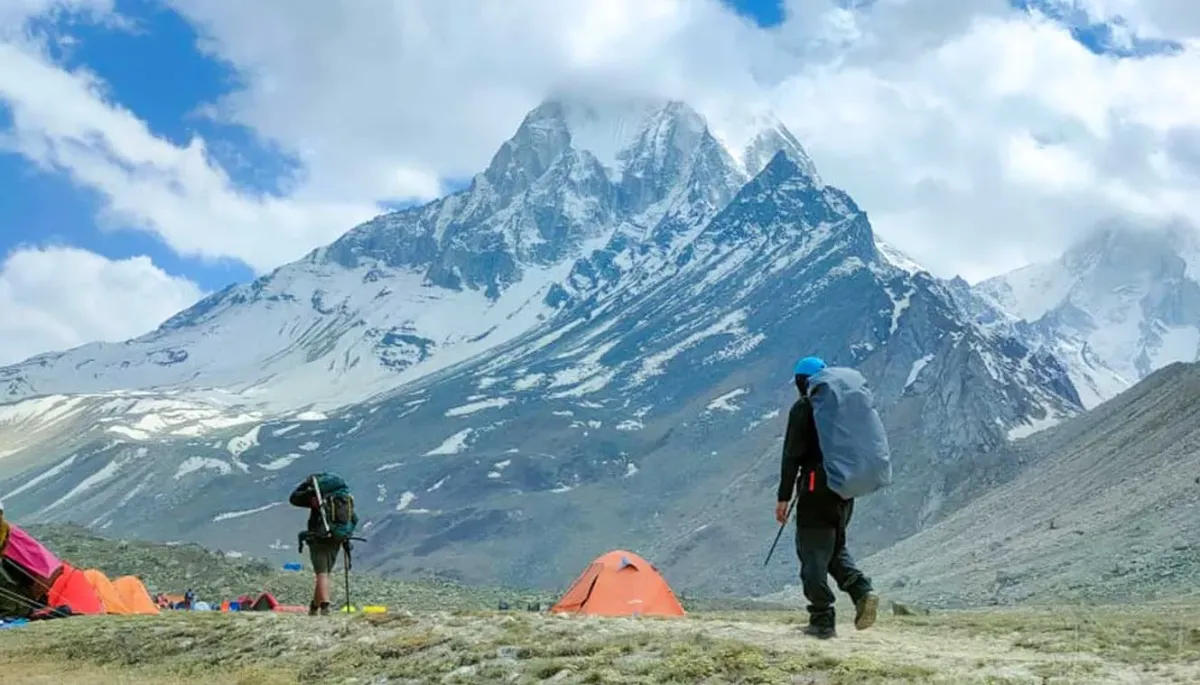
Tapovan To Bhojwasa via Gaumukh
-
Altitude: Bhojwasa - 3,800 m/ 12, 500 ft.
-
Trek Distance: 10 km | Duration: 5-6 hrs.
-
Descend through moraine and glacier till Gaumukh.
-
Accommodation in a tent.
-
Packed lunch.
-
Carry energy bars, ors, and water.
Rise early to cherish the few last moments in front of legendary mountains that are shining in the bright sun's rays and get ready to visit the Gaumukh Glacier. Mt. Shivling looks prettier than ever before, passing its beauty to the adjacent peaks. Together they all make a spectacular sight. It is time to take these memories back after having breakfast. Carry a packed lunch and enough water as you did earlier because there are no water sources.
Yes, again you have to cross the rocky terrain and moraines of the glacier. Descending is more difficult than ascending they say, you will realize this now as you make your way around the boulders. Watch your steps and move gradually. Try to relive the moments while you retrace the steps. Enjoy the forested sections of Bhojwasa once again with its flora and fauna.
It is quite a steep descent to Gaumkuh and today you will get to see the behemoth glacier from up close. Gaumukh is the end of the Gangotri glacier and hence the source of the divine Ganges river. Gaumukh means cow’s mouth, it is believed the snout looked like a cow's mouth in past. Most religious people consider it a blessing to visit the Ganges. Even if you are not religious you will be astonished to see how huge the snout is and how small you are in front of it.
The legend has it that once there was a powerful king named Sagar, who wished to perform the Ashwamedh Yajna with a ceremonial sacrifice horse. Fearing that Sagar will complete the Yajna, Lord Indra took the horse and tied it to the ashram of Lord Kapila where he used to meditate. Sagar sent out 60,000 of his sons to bring back the horse and when they were creating chaos in Kapila Muni’s ashram, his meditation got disrupted and he turned all of the 60000 sons to ashes and cursed that they would attain Moksha only if their ashes are washed in the water of the holy River Ganga, who then resided in heaven. All of Sagar's ancestors failed to please Brahma to bring Ganga to Earth, however, King Bhagirath was able to please Brahma and he ordered Ganga to flow down Earth. Goddess Ganga was not pleased with this and flowed with such intensity that she was about to drown the entire world. Bhagirath then prayed to Lord Shiva and Shiva agreed to capture Ganga in his locks to control the force and this is how Ganga arrived on Earth. To date, it is believed that a dip in the Ganga is enough to resolve all sins of an individual.
After a steep descent to Gaumukh, walk down the terrain alongside the Bhagirathi river. It will be a 5 to 6 hrs trek to Bhojwasa. Tonight we will camp here again before returning to Gangotri the following day.
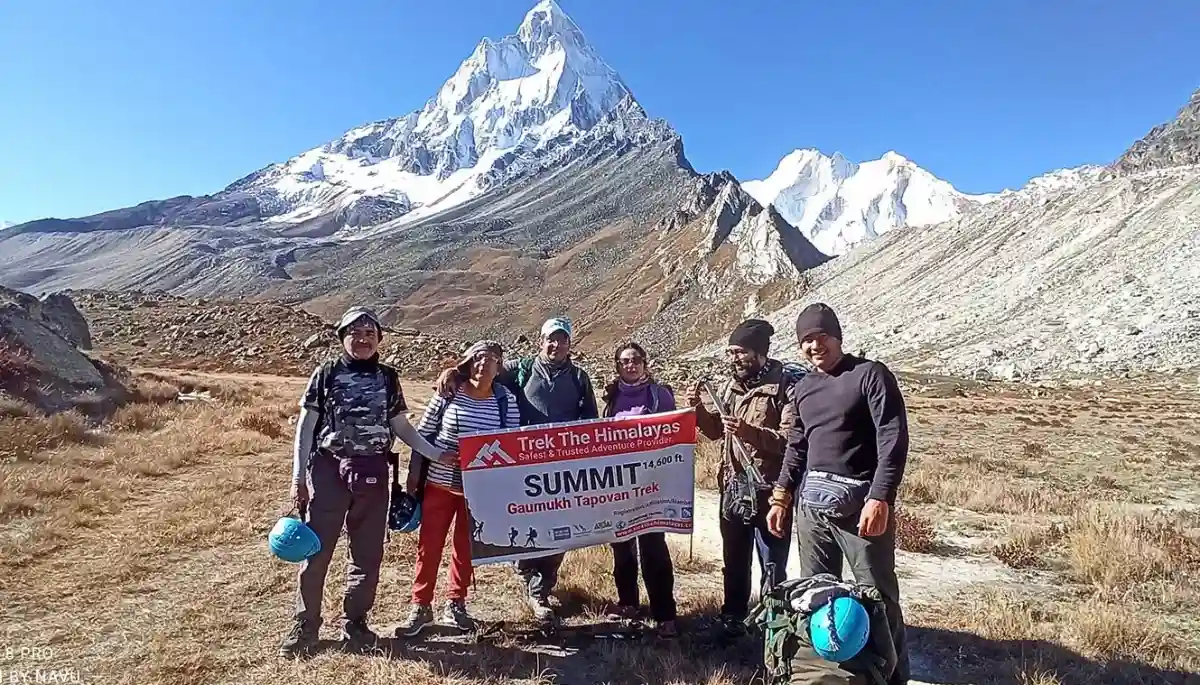
Bhojwasa To Gangotri
-
Altitude: 3,200 m/ 10,200 ft.
-
Trek Distance: 14 km | Duration: 6-7 hrs
-
Altitude Loss: 600 m/ 1,968 ft.
-
Accommodation in the guest house.
-
Moderate level of gradual descent.
-
Spring and manmade water points are available.
Wake up to realize that this will be the last day of the trek. Trek for around 6 to 7 hours covering 14 km to reach Gangotri. You will enter again in the Gangotri National Park, with the valley slowly closing behind you. Watch out for the rockfall section once again and you can catch upstreams and waterfalls to refill your water bottle. Say goodbye to the Bhagirathi and other mountain peaks as their sight now disappears.
Have a dinner in the guest house. Pack to return to Dehradun and thereby to your lovely homes.
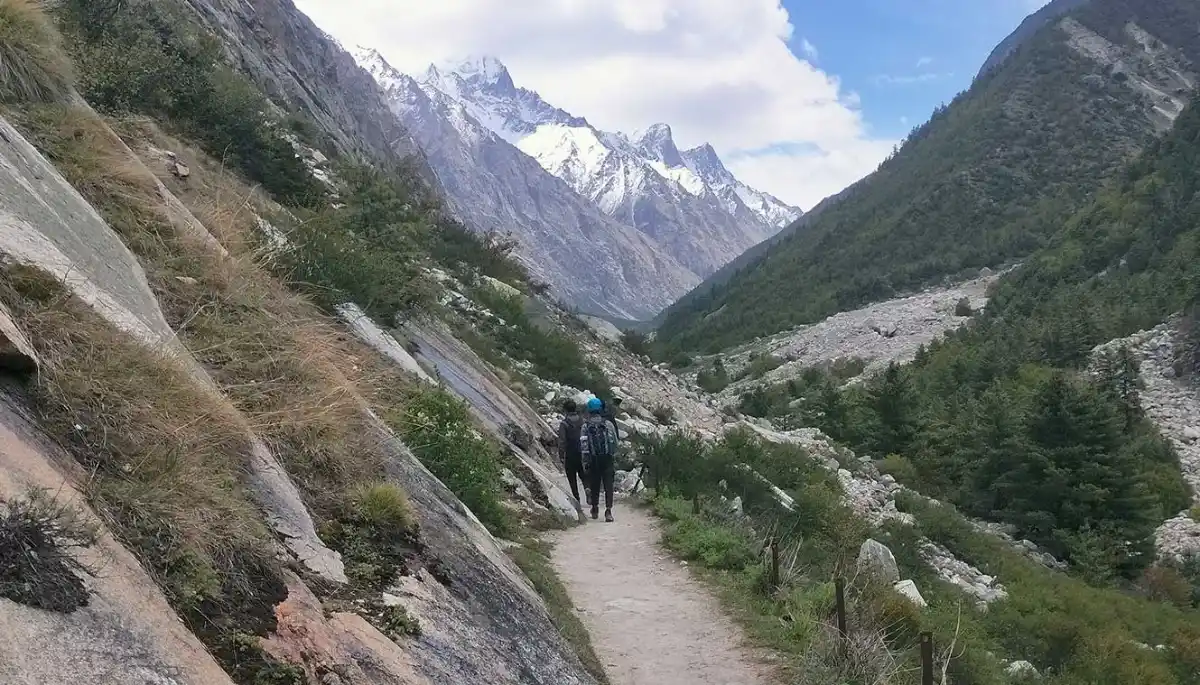
Depart For Dehradun
Have a final cup of morning tea in the mighty land of Gangotri. Say a final goodbye to your fellow trekkers and take back lots of memories. Take a wonderful group picture and get into the cab that will ride you back to Dehradun. This will be an 8-9 hours ride, between the mountains, valleys, and Bhagirathi river. The river guided us throughout the trek.
You will reach Dehradun by 5 PM, and from here you can lead your return journey as you have planned. We hope you take back loads of adventure-filled memories and take a pledge to come back to the mountains.
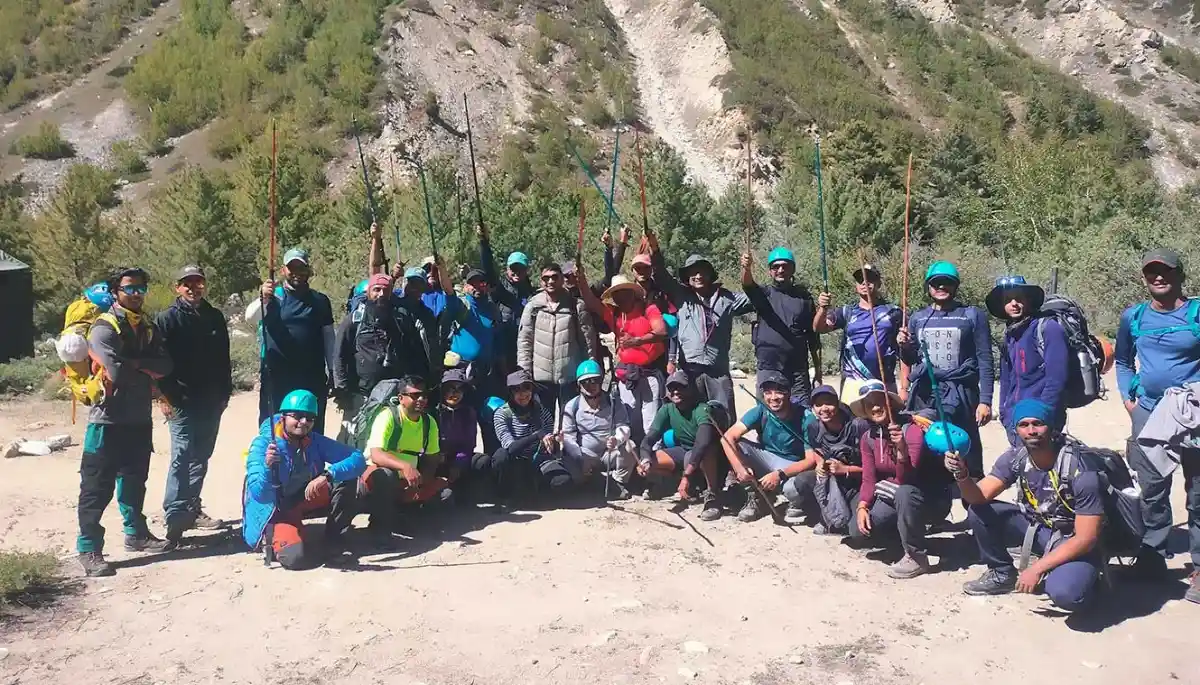
Day-1: Dehradun To Gangotri
- Altitude: 3,100 m/ 10,200 ft.
- Pick-up time: Dehradun railway station 6 am.
- Drive distance: 250 km (8-9 hrs).
Day-2: Acclimatization Day At Gangotri
- Altitude: 3,100 m/ 10,200 ft.
- After breakfast visit Pandav Gufa, Bhagirath Shila, Surya, and Gauri Kund.
- Post lunch can visit Gangotri Temple or go shopping.
Day-3: Gangotri To Chirbasa
- Altitude: 3,550 m/ 11,700 ft.
- Trek Distance: 9 km | 5 to 6 hrs.
Day-4: Chirbasa To Bhojwasa
- Altitude: 3,800 m/ 12,500 ft.
- Trek Distance: 5 km | Duration: 2 to 3 hrs.
Day-5: Bhojwasa To Tapovan
- Altitude: Tapovan - 4,450 m/ 14,600 ft.
- Trek Distance: 6 km| Duration: 7-8 hrs.
Day-6: Tapovan To Bhojwasa via Gaumukh
- Altitude: Bhojwasa - 3,800 m/ 12, 500 ft.
- Trek Distance: 6 km | Duration: 5-6 hrs.
Day-7: Bhojwasa To Gangotri
- Altitude: 3,200 m/ 10,200 ft.
- Trek Distance: 14 km | Duration: 6-7 hrs.
Day-8: Depart For Dehradun
- Gangotri to Dehradun Drive distance: 250 km (8-9 hrs)
- After morning tea towards Dehradun.
- Reach Dehradun by 5 to 6 Pm.
Graph
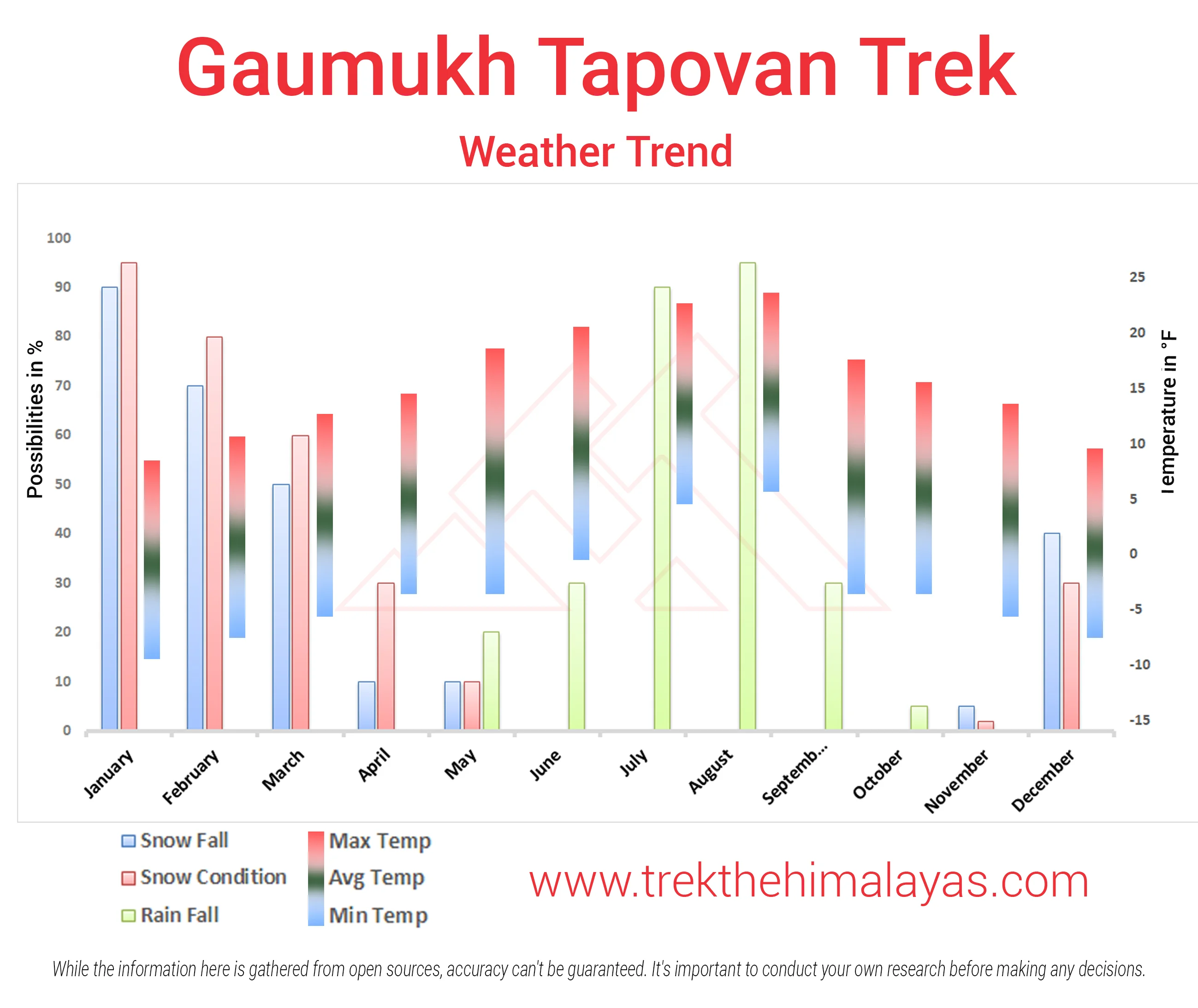
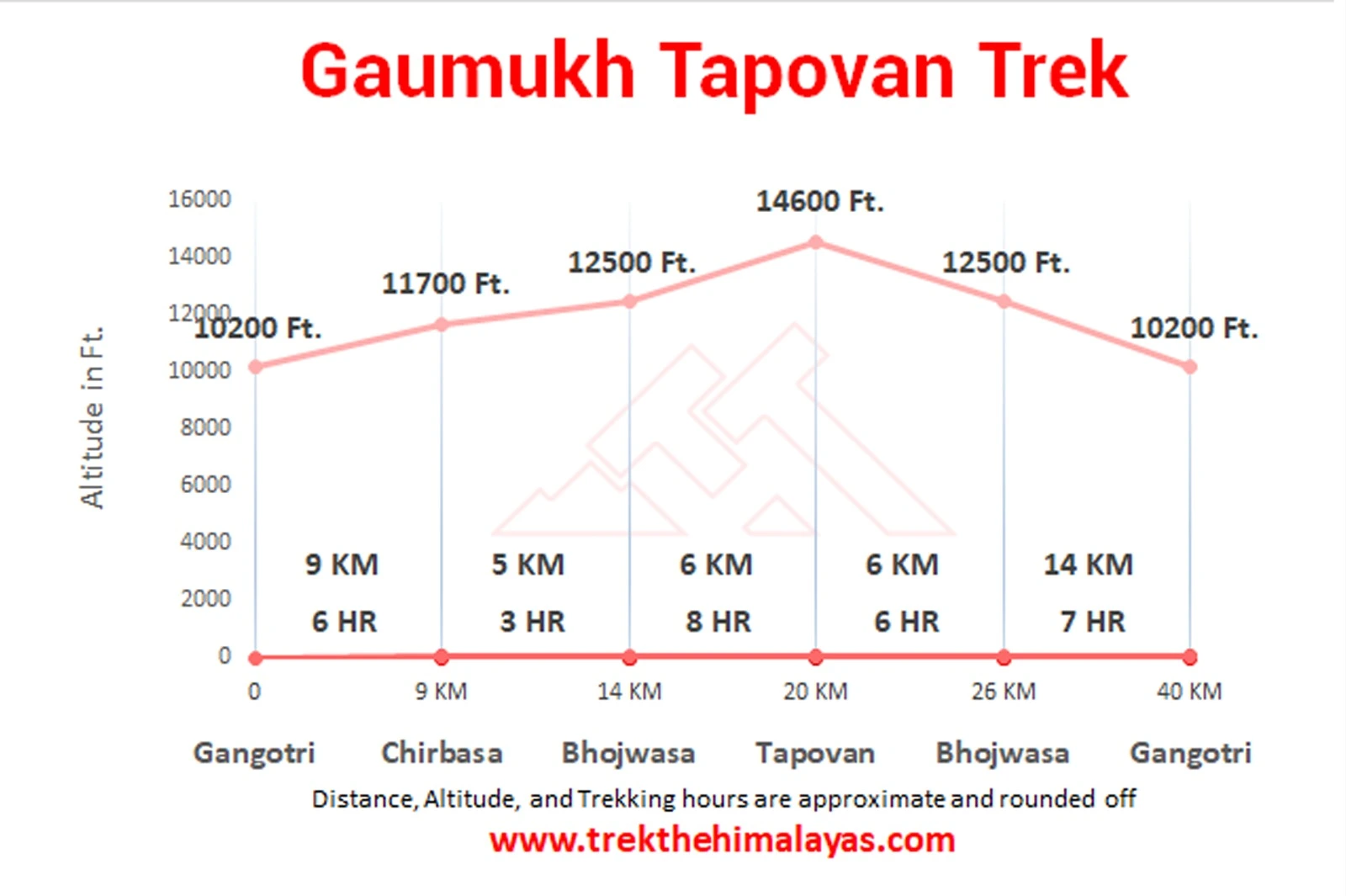
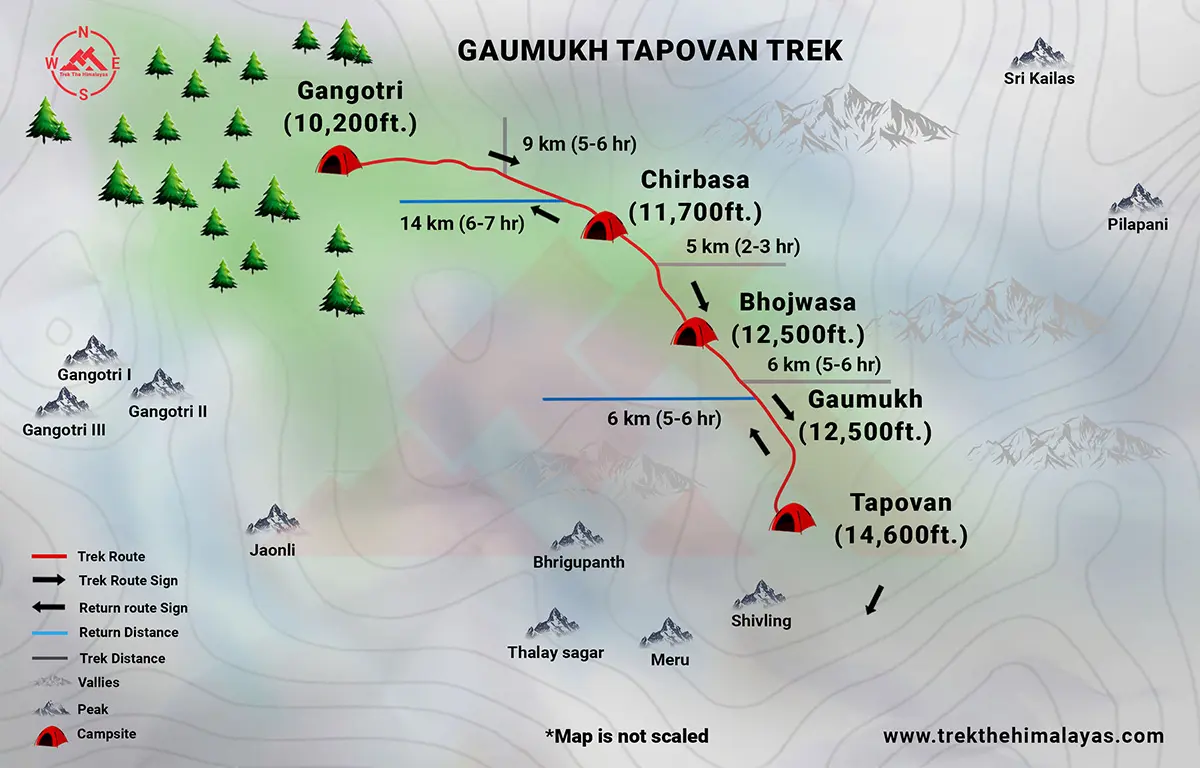
-
Pulse rate at rest must be in between (60 to 90 beats per minute).
-
Blood Pressure Reading must be in between (DIASTOLIC 70 – 90, SYSTOLIC 100 - 140 mm Hg).
-
Respiratory rate at rest must be in between (12 to 20 breaths per minute).
-
Should not have Liver and kidney issues.
-
Should not have Diabetes Mellitus, Bronchial Asthma, Heart problems, Hypertension, etc.
-
No pacemaker implant.
-
People with Sinus issues, Epilepsy please contact to trek coordinator before booking the trek.
-
If your BMI is not normal, Please contact our Trek coordinator before Trek booking.
Medical & Disclaimer Form (Mandatory Documents) Click here to download Medical & Disclaimer Form
- Government Employees can avail the benefit of Special Casual Leave (SCL) when they join us for a trekking expedition. As per the rules of the Pay Commission, Special Casual Leave can be availed for up to 30 days in a calendar year for trekking/mountaineering expeditions through a registered organization. Trek The Himalayas is a registered adventure tour operator by the Indian Mountaineering Foundation (IMF) and the Ministry Of Tourism (MOT).
- Trekkers have to apply for leave at least 20 days before the trek departure date.
- This service is exclusive to Indian government employees and is applicable only for treks within India.
- Do mail at info@trekthehimalayas to apply and mention your booked trek date and trek name.
- Junior trekkers (below 15 years) should have a company of parents/guardians.
- Trekkers between 15 to 18 years can come solo with the disclaimer form signed by parent/guardian.
- Medical & Disclaimer Form (Mandatory Documents) Click here to download Medical & Disclaimer Form
Important Links
Medical & Disclaimer Form (Mandatory Documents) Click Here.
How To Reach
Pick-Up Information
- It is essential for everyone to arrive at Dehradun Railway Station (06:00 am).
- Once you have reached Dehradun, TTH will manage the rest of your travel arrangements, if you have opted for TTH's pick-up service, you can select this option during the booking process by adding it as an add-on.
Options to Reach Dehradun
First, you can arrive at Delhi, Dehradun Airport or Chandigarh. The journey from these locations to Dehradun is explained below.
1. Take an overnight train from Delhi to Dehradun.
2. Take a bus to Dehradun ISBT from Delhi Kashmiri gate ISBT or Chandigarh Sector 17 Bus stand, and then take local transport to the pickup point (Dehradun Railway station).
Delhi to Dehradun - 250km | 6hr.
Chandigarh to Dehradun - 220km | 5hr
The distance from the Dehradun Bus Stand (ISBT) to the Railway Station is 6 km, without traffic, it will take 15 minutes.
( We always recommend to go for the govt. Buses over the private ones outside the bus station as based on the experience we have found that there are very high chances of delay involved with private buses. Also, govt. Buses are always more reliable. Whichever bus you choose, just make sure to reach Dehradun at least by 05:30 am positively. )
3. Take a flight to Dehradun airport (Jolly Grant Airport), then from the Airport to Dehradun Railway station Distance is 30km and it will take around 1 hr( if coming by flight then reach one day early).
Drop-Off Information
- The designated drop-off point is Dehradun Railway Station.
- Arrive in Dehradun Railway Station by 6:00 to 8:00 pm.
- Please consider planning your subsequent travel arrangements after 9:00 pm.
- The distance from the Railway Station to Dehradun Bus Stand (ISBT) is 6 km, it will take approx 25 minutes.
- The distance from Railway Station to Dehradun Airport is 30km, it will take approx 1hr.
- It's highly advisable to keep a buffer day in your travel plan. If the buffer day is not needed, it can be used to explore Dehradun/Mussoorie/Rishikesh.
( If you prefer to travel independently to Base camp and don't want to take TTH's pick-up service, you can either take a government bus or book a private cab from Rishikesh. Your trek coordinator will provide guidance on how to arrange for the bus or cab booking. )
TTH offers comfortable transportation through Tempo Traveler, Bolero, or equivalent vehicles. If you wish to upgrade your mode of transportation, please contact your trek coordinator for further assistance.
.webp)
.webp)
Cost Terms
Inclusion
1. Insurance.
2. Accommodation (as per the itinerary):
- Guest house stay, Type: triple, quad, dormitory (separate for male and female) on Day 1, Day 2 and Day 7.
- Camping: Twin sharing basis.
3. Meals (Veg + Egg):
- All meals starting from Day 1 Dinner to Day 7 Dinner as per the itinerary.
4. Support:
- 1 Versatile base camp manager: handles communication and deploys extra manpower in emergencies.
- 1 Mountaineering & First aid qualified professional trek Leader.
- 1 Experienced high-altitude chef.
- Local experienced guides (Number of guides depending on the group size).
- Enough support staff.
5. Trek equipment:
- Sleeping bag, Sleeping liners (if required), Mattress, Utensils.
- 3 men all season trekker tent (twin sharing), Kitchen & Dining tent, Toilet tent.
- Camping stool, Walkie talkie.
- Ropes, Helmet, Ice axe, Harness, Gaiters & Crampon (if required).
6. First aid:
- Medical kit, Stretcher, Oxygen cylinder, Blood pressure monitor, Oximeter, Stethoscope.
7. Mules/porters to carry the central luggage.
8. Clock room facility available at the base camp for additional luggage.
9. All necessary permits and entry fees, up to the amount charged for Indian.
10.Services from Gangotri to Gangotri
Exclusion
1. Food during the transit.
2. Any kind of personal expenses.
3. Mule or porter to carry personal luggage.
4. Emergency evacuation, hospitalization charge, etc.
5. Anything not specifically mentioned under the head Inclusion.
6. Transport cost.
Things can be provided on demand and availability (participant has to pay extra for these things).
1- Satellite phone/set phone - is a type of mobile phone that connects via radio links via satellites orbiting the Earth instead of terrestrial cell sites like cellphones. Therefore, they can operate in most geographic locations on the Earth's surface.
2- Gamow/PAC HAPO Bag (Portable Hyperbaric Bag) - is a unique, portable hyperbaric chamber for the treatment of acute mountain sickness (AMS), also known as altitude sickness.
3- AEDs (Automated External Defibrillators) - are portable life-saving devices designed to treat people experiencing sudden cardiac arrest, a medical condition in which the heart stops beating suddenly and unexpectedly.
Special Offer
- Make a single payment and trek the number of times you want.
- If you book a trek with Trek The Himalayas and cannot complete it, or if you've successfully completed the trek and wish to do it again, you can repeat it multiple times at no additional cost.
Terms and conditions
- This offer is non-transferable.
- This offer is valid for Trek The Himalayas limited fixed departures.
- This offer is valid for 5 years from the date of booking.
- This offer is not valid if the participant has received a cash refund or voucher at the time of cancellation.
- Participants don’t have to pay for the trek cost but have to pay for transportation and trek permit costs.
To reserve a spot for a trek or adventure program, you can either utilize our online booking form or call us at the provided number. For your confirmation, a deposit must be wired, including the initial payment.
Cancellation terms:
Cancellations prior to 25 days from the start of the Trip
Refund options
- 5% deduction of trek fee
- 100% cash voucher for any trip till one year
- Transfer your trek (any trek, any date) to your friend
Cancellation between 24 days and 15 days to the start of the Trip
Refund options
- 30% deduction of trek fee
- 100% cash voucher for same trip till one year
- 85% cash voucher for any trip till one year
- Transfer your trek (same trek, any date) to your friend
Cancellation between 14 days and 10 days to the start of the Trip
Refund options
- 50% deduction of trek fee
- 80% cash voucher for same trip till one year
- 70% cash voucher for any trip till one year
- Book the same trek, in the same season, with any other batch
- Transfer your trek (same trek, any date) to your friend
Cancellation less than 9 days to the start of the trek
Refund options
- No cash refund
- 20% cash voucher for the same trip till one year
- 10% cash voucher for any trip till one year
- Transfer your trek (same trek, same date) to your friend
Note- If a booking is made using a voucher or discount code, the policies related to vouchers and discounts cannot be modified.
In the unlikely event that TTH cancels a trek prior to the scheduled departure date:
While it is extremely rare for TTH to cancel a trek, we understand that unforeseen circumstances or natural disasters may occasionally require us to do so before the scheduled departure. These circumstances could include continuous rain or snow, thunderstorms, snowstorms, landslides, floods, earthquakes, or any other natural calamity that poses a risk to the safety of our trekkers. Additionally, unforeseeable events such as local riots, curfews, pandemics, lockdowns, government orders, or any similar situations that compromise the safety of the trekking experience may also necessitate a cancellation.
In the event of such a cancellation, TTH will provide you with a voucher equivalent to the amount you paid for the trek. This voucher can be redeemed for any of our treks within the next year, allowing you to still enjoy an adventure with us at a later date.
Note
-
The issuance of a voucher is not applicable in situations where you are required to descend from the trek for any reason. The trek leader may make the decision to send you down from the trek due to factors such as insufficient fitness level, symptoms of Acute Mountain Sickness (AMS), high blood pressure, exceeding the designated turn-around-time, health concerns, or if you are found smoking, drinking, or violating the rules set for the trek. In such cases, the provision of a voucher does not apply.
In the rare event that TTH shifts a trek:
We would like to emphasize that weather conditions in high-altitude areas are highly unpredictable and can undergo sudden changes at any time, irrespective of the day. Additionally, circumstances beyond our control, such as natural disasters, political unrest, pandemics, and lockdowns, may impact the feasibility of conducting a trek. In cases where we are unable to proceed with an event due to such circumstances that are beyond our direct control, we will make every effort to provide you with an alternative trek that is safer and more suitable.
In such situations, we will issue a voucher to offset the cost difference between the originally scheduled trek and the alternative trek. This voucher can be redeemed at any time within one year from the date of issue. Please note that a refund fee or reimbursement of the cost difference is not applicable in these cases.
Note:
- Change of trek batch is dependent on the availability of seats in the batch
- In case of transferring a trek to a friend, he/she should satisfy all the mandatory requirements put forward by TTH
- TTH holds the right to change/cancel the policies, without prior notice
- Cash refund is applicable only in case of bookings made without using any promotional offer code or vouchers
Cash Voucher Terms:
- This is a non-transferable voucher
- The voucher cannot be merged with any other offer of Trek The Himalayas
- The voucher is valid for Trek booked directly with Trek The Himalayas in India
- To avail the voucher please use your register phone number or e-mail id
- All the other Terms of booking a trek with Trek The Himalayas are applicable to the voucher
- Trek The Himalayas holds rights to add/remove any of the Terms and Conditions without prior notice
Itineraries are based on information available at the time of planning and are subject to change. "Trek The Himalayas" reserves the right to change expedition dates, people or itineraries as conditions warrant. If a trip must be delayed or the itinerary changed due to bad weather, road conditions, transportation delays, government intervention, airline schedules, sickness, or other contingency for which TTH or its agents cannot make provision, the cost of delays and/or other changes are the responsibility of the participant. TTH reserves the right to decline, or accept, any individual as a trip member for any reason whatsoever.
Trek Essentials
PDF Of Trek Essential Download
| Backpack with rain cover | (50 - 60 ltr) with comfortable shoulder straps |
| Day pack with rain cover | 20 - 30 ltr (If off-load opted) |
| Walking stick | Advisable (At least one) |
| Water Bottle / Hydration pack | 2 bottles of one liter each, People who use hydration pack 1 hydration pack and 1 bottle of one liter, Carry at least one thermos flask. |
| Small size tiffin/lunch box | 1 Nos |
| Snacks | Energy bars, dry fruits, electoral/ors |
| Personal Medical Kit | Consult your doctor |
| T-Shirt (Synthetic quick dry) | 1 Full & 2 Half sleeves |
| Fleece T-shirt | 1 Nos |
| Wind stopper / Fleece jacket | 1 Nos |
| Windproof Jacket | 1 Nos |
| Down feather / Hollow jacket | 1 Nos |
| Thermal inner (Upper and Lower) | 1 Pair |
| Trek Pant (Synthetic quick dry) | 2 Nos |
| Wind stopper / Fleece Pant | 1 Nos |
| Waterproof gloves | 1 Pair |
| Fleece / woollen gloves | 1 Pair |
| Poncho / waterproof Jacket and pant | 1 Nos |
| Sunscreen | 1 Nos |
| Moisturiser | 1 Nos |
| Chap-stick / Lip balm | 1 Nos |
| Toothbrush and toothpaste | 1 Nos |
| Toilet paper & Wipes | 1 Nos |
| Soap / hand sanitizers | 1 Nos |
| Antibacterial powder | 1 Nos |
| Quick dry towel | 1 Nos |
| Head torch | 1 Nos. (Avoid Hand torch) |
| Sun Cap | 1 Nos |
| Woolen cap | 1 Nos. |
| Balaclava | 1 Nos. |
| Buff / Neck-gaiters | 1 Synthetic & 1 Woollen |
| Sunglasses | UV with dark side cover, People who wear spectacles - (A)- Use contact lenses | (B)- Photo chromatic glasses |
| Trekking shoes | 1 Pair (Waterproof, high ankle, good grip) |
| Floaters / flip-flops | 1 Pair |
| Cotton socks | 6 pairs |
| Woollen socks | 1 pairs |
| Gaiters | 1 Pair (TTH provides when required) |
| Micro spikes | 1 Pair (TTH provides when required) |

Frequently Asked Questions(FAQ)
To register with TTH, visit our website - www.trekthehimalayas.com and create your account. To create your account you will need to use your email address and fill in all the details, set your unique password and your account is ready to use.
- To book a trek with TTH, you first need to register with us and create an account.
- Choose the trek that you want to do and click on available dates.
- You will land at the login page, fill in the required details.
- Add Participants, choose add-on services click on the Pay now button, choose your preferred payment method, and make the payment. TTH accepts multiple payment options, including credit/debit cards, net banking, and UPI.
- You will receive a confirmation email from TTH with all the necessary details about the trek, including the meeting point, transportation, accommodation, and other important instructions.
please send an email to us at info@trekthehimalayas.com or reach out to the numbers provided in the Help and Support section of your Trek Page. We will ensure that your issue is promptly resolved.
To book services such as off-load luggage and transportation, you can find them listed as add-ons. These additional services can be booked at the time of your initial booking. If you miss booking add-ons during the initial reservation, you can log in anytime and easily book 4 days before the departure date add-ons through the platform.
In such a situation, please log in to your account and transfer your trek or date to the desired one within 12 hours or drop us an email at info@trekthehimalayas.com 10 days before the departure date of the trek. After the initial 12-hour period, any changes will be processed according to the cancellation policy.
We recommend visiting our "Suggest Me a Trek" page. By filling out the form, our experts will contact you with the best possible trek options based on your preferences and experience level. Alternatively, you can reach out to us via email at info@trekthehimalayas.com or give us a call using the numbers provided on our website for personalized assistance and recommendations.
Family treks differ from regular treks by focusing on ease of difficulty, offering shorter durations for younger participants, Kid-friendly and easily digestible foods, child-friendly activities, maintaining a higher guide ratio for diverse age groups, and implementing additional safety measures for families.
Family Trek with Kids recommendation Only Dayara Bugyal and Chopta Chandrashila Trek.
Minimum age for TTH treks is typically 7 years, though this may vary depending on the specific trek.
Yes, you can take a kids to a high-altitude trek with a parent. Discuss with a trek expert before booking a trek.
Junior trekkers (below 15 years) should have a company of parents/guardians.
Trekkers between 15 to 18 years can come solo with the disclaimer form signed by parent/guardian.
Medical & Disclaimer Form (Mandatory Documents) Click here to download medical and disclaimer form
Physical Fitness: Ensure your child is physically fit. Engage them in regular exercise, outdoor activities, and hikes to build stamina and endurance. Hydration: Emphasize the importance of staying hydrated at high altitudes. Encourage your child to drink water regularly, even if they don't feel thirsty. Proper Nutrition: Provide a well-balanced diet with sufficient carbohydrates for energy and foods rich in iron to prevent altitude sickness. Adequate Sleep: Ensure your child gets enough sleep in the days leading up to the trek. Quality rest is crucial for altitude adaptation. Educate on Altitude Sickness: Teach your child about the symptoms of altitude sickness, such as headache, nausea, and dizziness. Encourage them to communicate any discomfort immediately. Appropriate Clothing and Gear: Dress your child in layers to adjust to changing temperatures. Ensure they have appropriate trekking gear, including sturdy footwear. Positive Mindset: Foster a positive mindset. Encourage your child, and let them know it's okay to take breaks when needed. Medical Check-Up: Schedule a medical check-up before the trek to ensure your child is fit for high-altitude activities. Consult with a healthcare professional about any potential health concerns.
TTH takes special care to provide wholesome and nutritious food for children on treks. Here are some of the foods that are typically served for children:
Breakfast: For breakfast, TTH serves a variety of options like porridge, cornflakes, bread, butter, jam, honey, boiled eggs, omelettes, and pancakes. Children can choose from these options to fuel themselves for the day's trek.
Lunch: For lunch, TTH serves lunch which includes rotis, vegetables, rice, dal, and salad. The rotis are usually made fresh on the trek and are a good source of carbohydrates. The dal and vegetables provide protein and other essential nutrients.
Snacks: TTH provides healthy snacks like fresh fruits, dry fruits, energy bars, cookies, and biscuits to keep the children energized throughout the day.
Dinner: For dinner, TTH serves a hot and wholesome meal which includes soup, rice, dal, vegetables, and a non-vegetarian dish (if requested in advance). Children can also choose from a variety of desserts like custard, jelly, and fruit salad.
Dietary requirements: If a child has any special dietary requirements, TTH can cater to those needs as well. For example, if a child is lactose intolerant or allergic to nuts, the kitchen staff can make arrangements to accommodate those requirements.
Choosing the right trek for a beginner can be a bit overwhelming as there are many factors to consider such as distance, elevation gain, terrain difficulty, weather, and time of year. Here are some tips that can help you choose the right trek for a beginner:
1. Determine fitness level: Assess the fitness level of the beginner to understand their physical capabilities. This will help you select a trek that is challenging but not too difficult.
2. Choose a well-traveled trail: A well-traveled trail will have more amenities such as signposts, water stations, and shelter. It is also safer as there will be other hikers on the trail.
3. Consider the length of the trek: For beginners, it is recommended to start with a shorter trek that can be completed in a day or two. This will help them get acclimatized to trekking and build their confidence.
4. Look for gradual elevation gain: Choose a trek with a gradual elevation gain rather than steep ascents. This will make the trek easier and more enjoyable.
5. Check the weather: Check the weather forecast before selecting a trek. Avoid treks during the monsoon season or winter when the trails can be slippery or dangerous.
6. Research the trail: Read about the trail to get an idea of the terrain, altitude, and difficulty level. This will help you select a trek that is suitable for the beginner.
7. Consult with an expert: If you are unsure about which trek to choose, consult our trek expert Mr. Nitin (+91 70600 59773) between 10 AM to 6 PM (Tuesday - Friday). Mr. Nitin will provide you valuable advice and guidance.
Overall, it is important to choose a trek that is enjoyable, challenging but not too difficult, and suitable for the beginner's fitness level and experience.
It is not recommended for a beginner to choose a difficult Himalayan trek. Trekking in the Himalayas can be physically and mentally challenging, especially if you are not used to the high altitude, steep slopes, and rugged terrain. Choosing a difficult trek without the proper experience, fitness level, and preparation can be dangerous and put you at risk of altitude sickness, injury, and other hazards.
If you are a beginner, it is recommended to start with an easier trek and gradually build up your skills and experience. This will help you understand the challenges of trekking in the Himalayas, and also prepare you physically and mentally for a more difficult trek in the future. It is also important to choose a trek that matches your fitness level, experience, and interest.
There is no specific age limit for a beginner trekker. However, it is important to consider your physical fitness, health condition, and personal interests before embarking on a trek. Trekking in the Himalayas can be physically and mentally demanding, and requires a certain level of physical fitness and endurance.
If you have any pre-existing medical conditions or are above a certain age, it is recommended to consult with a doctor before embarking on a trek. It is also important to listen to your body and take breaks as needed during the trek to prevent exhaustion or injury.
We recommend visiting our "Suggest Me a Trek" page. By filling out the form, our experts will contact you with the best possible trek options based on your preferences and experience level. Alternatively, you can reach out to us via email at info@trekthehimalayas.com or give us a call using the numbers provided on our website for personalized assistance and recommendations.
Yes, you can join the trek. We have fixed departure groups where you can simply book your trek and we will take care of curating a group.
Before you start the trek, it is recommended that you make all the necessary phone calls as during the trek you may or may not receive network coverage, once you come back to the Base Camp, you can reconnect with your family via phone once again. You can share your trek coordinator contact detail with your family members to get the latest updates about your trek batch.
At TTH, we provide wholesome and nutritious meals during the trek. The food is vegetarian and includes a variety of dishes such as rice, dal, vegetables, chapati, paratha, pasta, noodles, and soup. We also offer snacks such as biscuits, and salty, and dry fruits during the trek. Special dietary requirements such as vegan, gluten-free, or Jain food can also be arranged if informed in advance.
If you are allergic to some foods, you need to let us know in advance so that we can make arrangements accordingly.
TTH is a trekking company that prioritizes the safety of all its participants, including women trekkers. They have a comprehensive safety system in place, which includes a dedicated team of experienced and trained trek leaders and support staff who are equipped to handle emergency situations and provide first aid.
TTH also takes specific measures to ensure the safety and comfort of women trekkers. They have a separate tent accommodation for women trekkers, female trek leaders, and support staff. They also provide separate toilet facilities for women and encourage a safe and respectful environment for all trekkers.
Moreover, TTH has a strict policy against any kind of harassment and has a zero-tolerance policy towards such incidents. They have a designated Internal Complaints Committee (ICC) to investigate and address any complaints related to harassment or misconduct. Overall, TTH has a good reputation for safety and responsible trekking practices, and women can feel comfortable and safe while trekking with them.
In case you are the only women in the group, we provide a single sleeping arrangement. Also, during the trek, the trek leader will always remain by your side to provide optimum safety and reassurance.
You can reach out to the trek coordinator to inquire about the number of female trekkers and their respective states who have booked the trek. Please note that the trek coordinator cannot disclose personal details of any trekker. Once you've confirmed your booking, a WhatsApp Group will be created for all the trekkers in your batch. This allows you to connect with fellow trekkers before the trek begins.
While many of our treks are led by female trek leaders, however, it is not possible to know which trek leader is assigned to which group. But nonetheless, whether the trek leader is male or female you can be completely assured of your safety and security with us.
Yes, it is possible to trek with periods. However, it is important to take some extra precautions and preparations to ensure a comfortable and safe trekking experience.
Here are some tips that can help you trek during your period:
1. Use menstrual hygiene products that you are comfortable with, such as tampons, pads, or menstrual cups. It is recommended to carry enough supplies for the entire duration of the trek.
2. Pack wet wipes, hand sanitizer, and plastic bags to dispose of used hygiene products.
3. Wear comfortable and breathable clothing that allows for easy movement and reduces friction. Avoid wearing tight or restrictive clothing that can cause discomfort.
4. Carry pain relief medication, such as ibuprofen or acetaminophen, in case of menstrual cramps.
5. Stay hydrated and maintain a balanced diet to support your energy levels and overall health.
6. Take breaks as needed and listen to your body. If you feel uncomfortable or experience any unusual symptoms, seek medical attention immediately.
It is also recommended to consult with a doctor before going on a trek during your period, especially if you have a pre-existing medical condition or are taking medication. By taking necessary precautions and being prepared, you can have a safe and comfortable trekking experience even during your period.
We provide proper disposal facilities for sanitary pad disposal during the trek.
We offer three person tents with twin-sharing for optimum comfort. A woman trekker will share a tent with another woman trekker and if you are the only woman in the group, you will be given a single accommodation for your comfort and privacy.
Yes, we do provide gears on rent. You can book it using you TTH account directly.
Mountaineering qualified Experienced and first aid certified Trek Leader, First Aid Certify local guide, Cook, helpers and supporting staff.
People suffering from Bronchitis, Asthma, High blood pressure, Epilepsy (got faints), TB , Heart problem or on higher BMI side are strictly not allowed to go on any Himalayan trek. Apart from this if you had any medical history, please let us know.
No. Alcohol and smoking isn’t allowed while on trek. It is totally misconception that it will keep you warm. Your body need to acclimatize properly and for that eat properly and drink enough water; these things will keep you warm.
Toilet tents provide a convenient solution for answering nature's call in the great outdoors. Dry toilets, in particular, offer a highly sanitary approach. By digging a pit and utilizing mud and a shovel, you can easily cover up your waste. This method ensures cleanliness and hygiene while camping or exploring in the forest.
Remember to pack essential toiletries to complete your outdoor bathroom kit and maintain proper personal hygiene during your adventures. With these practices in place, you can enjoy nature while also respecting it.
Layer Up From Head To Toe
Eat Full Meals, never sleep empty stomach
You can keep warmee (if you’re more susceptible to cold).
Use sleeping bag in right way and don’t leave free space in sleeping bag.
For upper body
– Thermal layer
– T-shirt (full-sleeves)
– Fleece T-shirt (for extreme colds)
– Fleece layer
– Thick Jacket/Down Jacket
– Waterproof or Windproof layer (outermost layer, when it is snowing or raining)
- For Lower Body
– Thermal layer
– Hiking pants (normal) or Winter hiking pants
Based on how warm you feel you can skip any of the above layers. Your outer later should be windproof since it is windy at high altitude.
The idea behind layering is that the more insulation you have the less cold you feel, and instead of wearing a very thick jacket if you wear multiple layers, your body will be better insulated against the cold.
Yes, we provide micro spikes and gaiters, if required.
Mandatory documents: 2 xerox of ID having address (addhar card/driving license), 2 Passport size photographs, hard copy Medical form signed & sealed by doctor, disclaimer form sign by trekker and high altitude insurance.
No. We don’t but we can suggest you good hotel/Stay nearby pick up location.
Yes, trekker must carry 2 water bottles 1 litre each so they can refill it at campsite for drinking and keep themselves hydrate.
You should buy shoes which has these three features –Good grip, Ankle Support and additional water resistant layers. Generally, we advise Quechua Trek 100, MH 500 and MH 100.
No one is forced to go on. There is always enough staff to split the party according to need and regroup later at the camp. Most people have no trouble reaching the highest campsite. If some members decide not to climb the final distance they can wait for the climbers to come back down the same way or take a lateral path to the descent route.
Gaumukh Tapovan Trek takes you to the Gaumukh Glacier, believed to be the origin of the river Ganges.
Begin your journey with a visit to Gangotri Dham, one of the Char Dham pilgrimage sites in Uttarakhand.
Experience the beauty of Chirbasa, a picturesque campsite nestled amidst mountains, with the Bhagirathi River flowing beside it.
Reach the Bhojwasa campsite, adorned with ancient Bhoj trees.
Encounter the crevasses on the glacier near Gaumukh, offering an adventurous experience as you traverse from one glacier to another.
Trek to the enchanting Tapovan meadows, a place where sages and ascetics seek solace and enhance their spiritual practices.
Marvel at the breathtaking views of the Bhagirathi Peaks and the iconic Mt. Shivling.
The beautiful sunrises and sunsets over the Bhaghirathi Peaks are something that cannot be missed.
Gain insights into the traditional Himalayan way of life as you pass through the remote villages.
It takes 8-days to complete the Gaumukh Tapovan Trek.
The approximate Gaumukh trek distance is 46 km.
The Gaumukh Tapovan trek is graded as Moderate to Difficult level of trek.
Best time for Gaumukh Tapovan trek is during the summer months from May to June and the post-monsoon months from September to October. During these times, the weather is relatively stable, and the trekking conditions are ideal.
From Gaumukh, prominent peaks such as Mount Shivling, Bhagirathi Twin Peaks, and Mount Meru are visible.
Previous trekking experience is not mandatory for Gaumukh Tapovan Trek although a good level of physical fitness is necessary to enjoy the trekking experience.
A high level of physical fitness is required for the Gaumukh Tapovan trek. Participants should be in good health and prepared for strenuous physical activity over several days.
The highest point on the Gaumukh Tapovan Trek is the Tapovan Meadows. Tapovan height is 14,600 ft.
Accommodation on the Gaumukh Tapovan trek typically consists of tents. Campgrounds are set up at various points along the route, providing basic shelter and amenities.
If you are a solo trekker, you can join our fixed departures to Gaumukh Tapovan and we will pair you with like-minded trekkers ensuring a rich trekking experience.
Yes, there is a chance of Acute Mountain Sickness (AMS) on the Gaumukh Tapovan trek due to the high altitude. We make sure to acclimatize properly and follow a gradual altitude gain to reduce the chances of AMS. As a responsible trekker, you can educate yourself about the signs and symptoms of AMS and immediately report to your Trek Leader if you notice any such signs.
Yes, there is a possibility of encountering snow on the Gaumukh Tapovan trek, especially at higher altitudes during late autumn season.
Explore Most Informative Articles on Gaumukh Tapovan Trek
Help & Support
+91 9368882322 info@trekthehimalayas.com10:00 hrs to 18:00 hrs | GMT +5:30
Monday - Saturday | Sunday Closed
.webp)
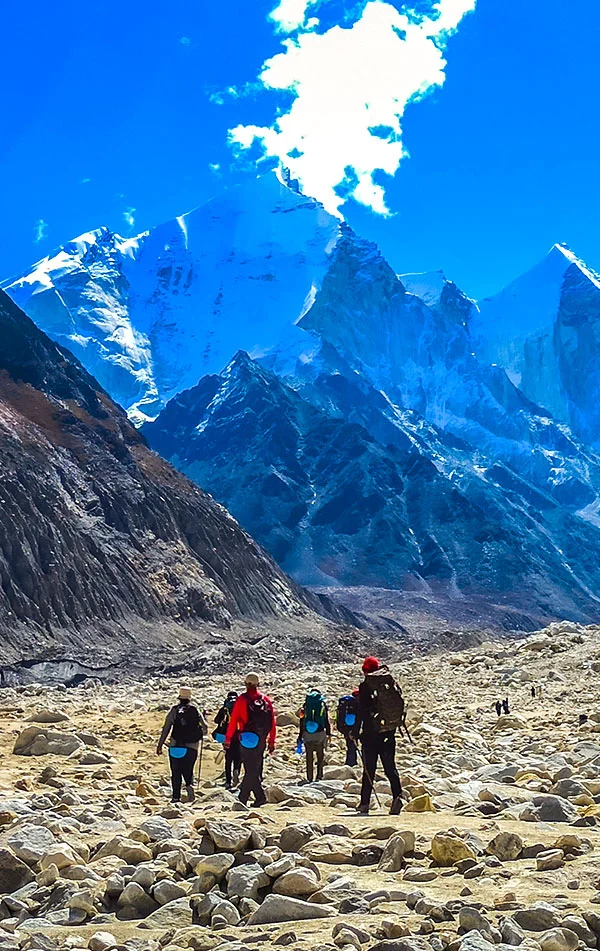
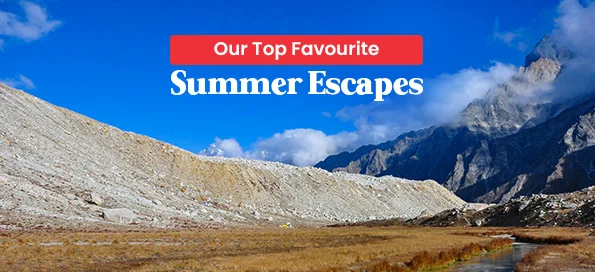
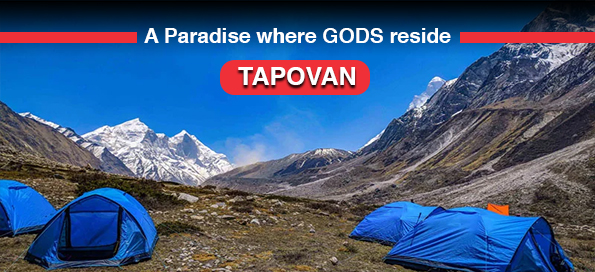
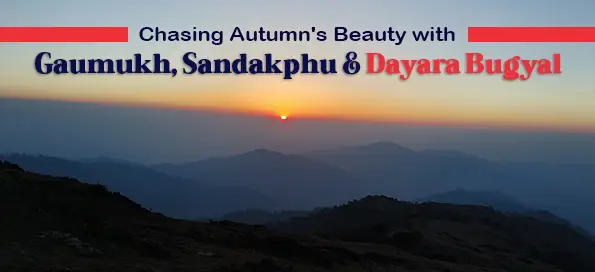
.webp)
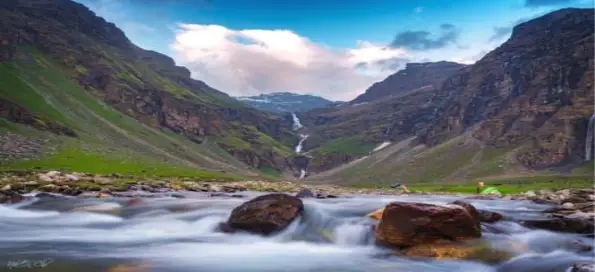
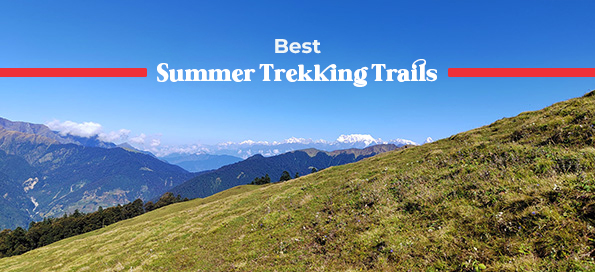
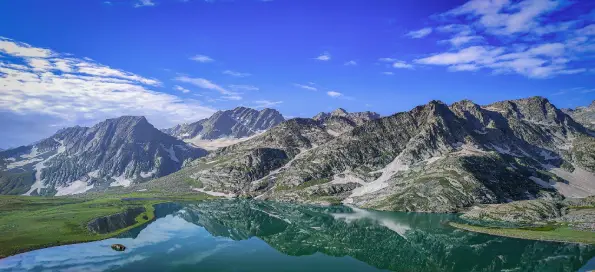
.webp)
